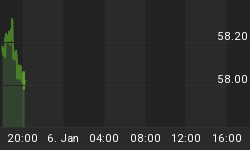Hope is never a good strategy, but hope is all the bulls seem to have left. This past week's failed signal is not a good sign for the bulls and could be particularly ominous. This is how bear markets start. On the other hand, there is always hope that the failed signal will just be a fake out. It has happened in the past, and such fake outs have led to very strong upward moves. This scenario seems less likely. Yet, the "dumb money" indicator has turned bearish and in general, this is a bullish signal. However, within the context of a failed signal, we need more supporting evidence, such as bullishness from the "smart money" or from company insiders, before we can make the call for our next "fat pitch".
The "Dumb Money" indicator (see figure 1) looks for extremes in the data from 4 different groups of investors who historically have been wrong on the market: 1) Investor Intelligence; 2) Market Vane; 3) American Association of Individual Investors; and 4) the put call ratio. The "Dumb Money" indicator is now bearish. The "sweet spot" for buying typically occurs after two consecutive weeks of bearish investor sentiment, but once again, it is important to see additional evidence from the other sentiment indicators.
Figure 1. "Dumb Money"/ weekly
The "Smart Money" indicator is shown in figure 2. The "smart money indicator is a composite of the following data: 1) public to specialist short ratio; 2) specialist short to total short ratio; 3) SP100 option traders. As of this past Friday, the "Smart Money" indicator is bullish/neutral.
Figure 2. "Smart Money"/weekly
Figure 3 is a weekly chart of the S&P500 with the InsiderScore "entire market" value in the lower panel. From the InsiderScore weekly report: buying and selling slowed considerably due to the quarter ending and it remained without conviction.
Figure 3. InsiderScore "Entire Market" Value/ weekly
Figure 4 is a weekly chart of the S&P500. The indicator in the lower panel measures all the assets in the Rydex bullish oriented equity funds divided by the sum of assets in the bullish oriented equity funds plus the assets in the bearish oriented equity funds. When the indicator is green, the value is low and there is fear in the market; this is where market bottoms are forged. When the indicator is red, there is complacency in the market. There are too many bulls and this is when market advances stall.
Currently, the value of the indicator is 45.92%. Values less than 50% are associated with market bottoms.
Figure 4. Rydex Total Bull v. Total Bear/ weekly
Were you buying at the market top? Wondering when to buy the dip?
Improve your market timing with Premium Content from TheTechnicalTake. For a nominal yearly fee, you will get a unique data set that will show you which way investors (i.e., bull market geniuses) are leaning.
It is independent and original market analysis. To view a recent report click: REPORT.
















